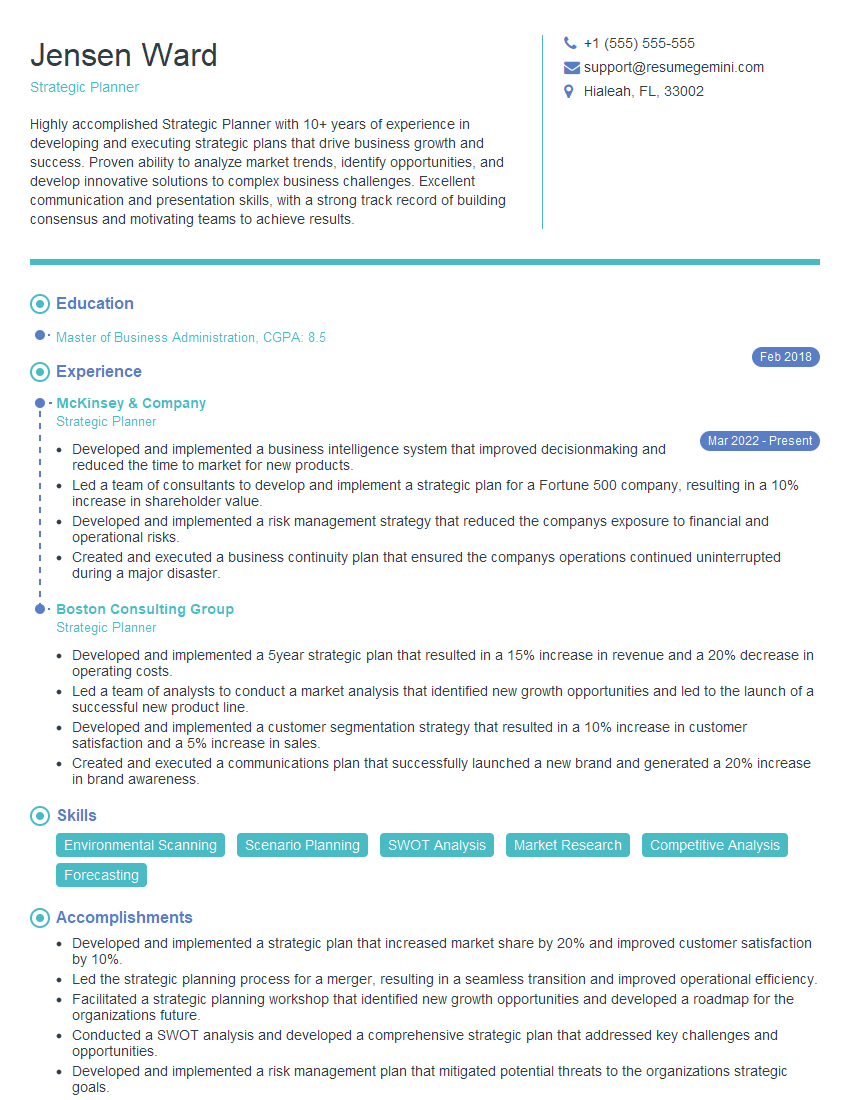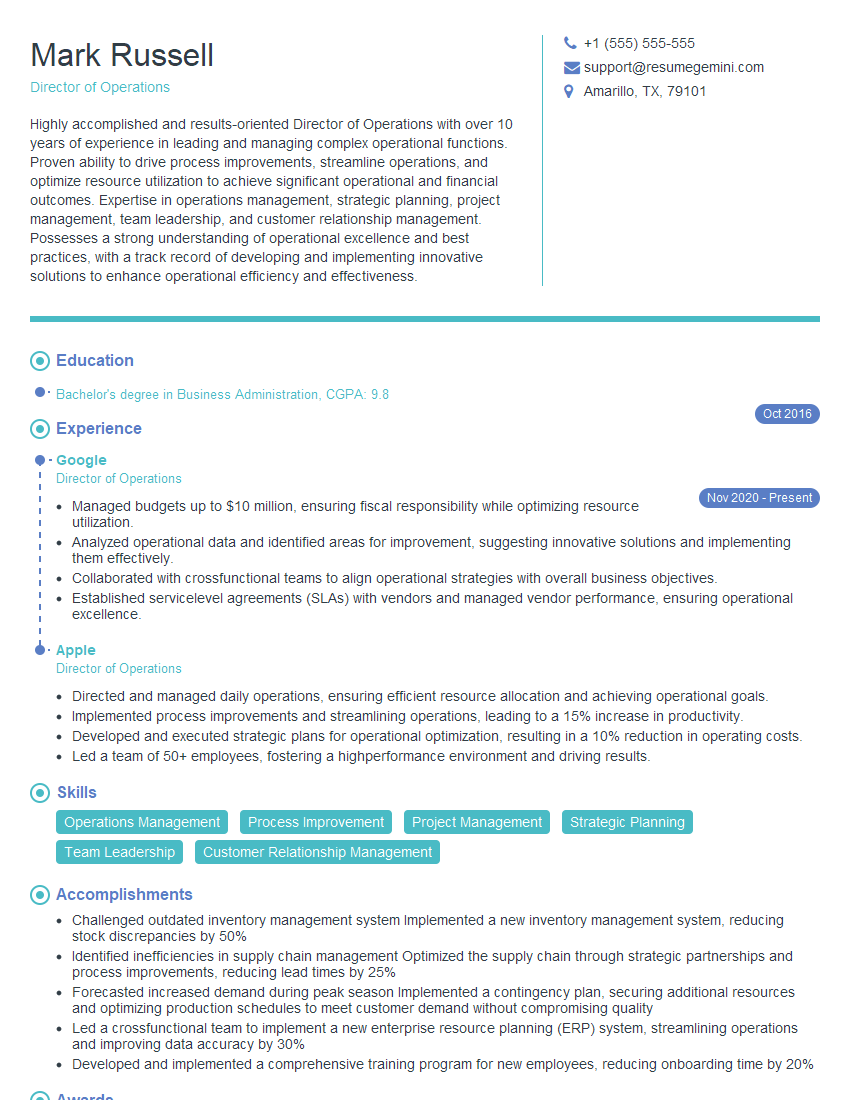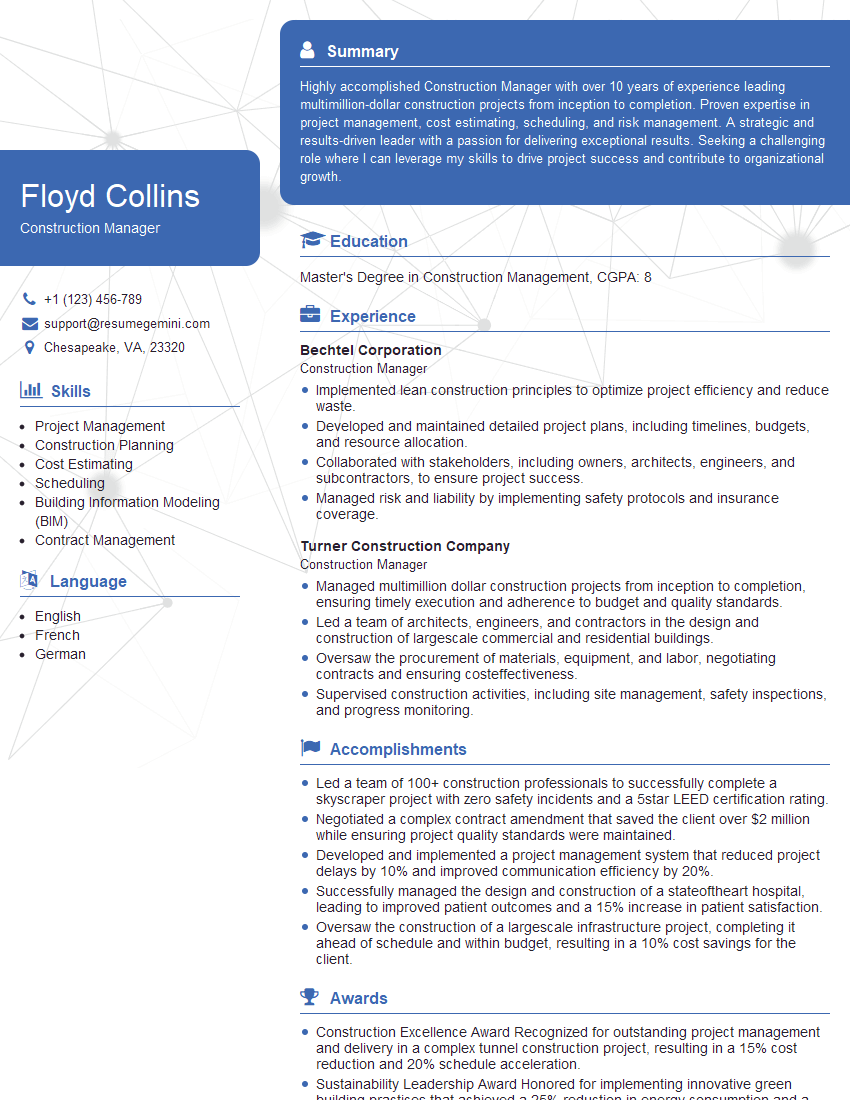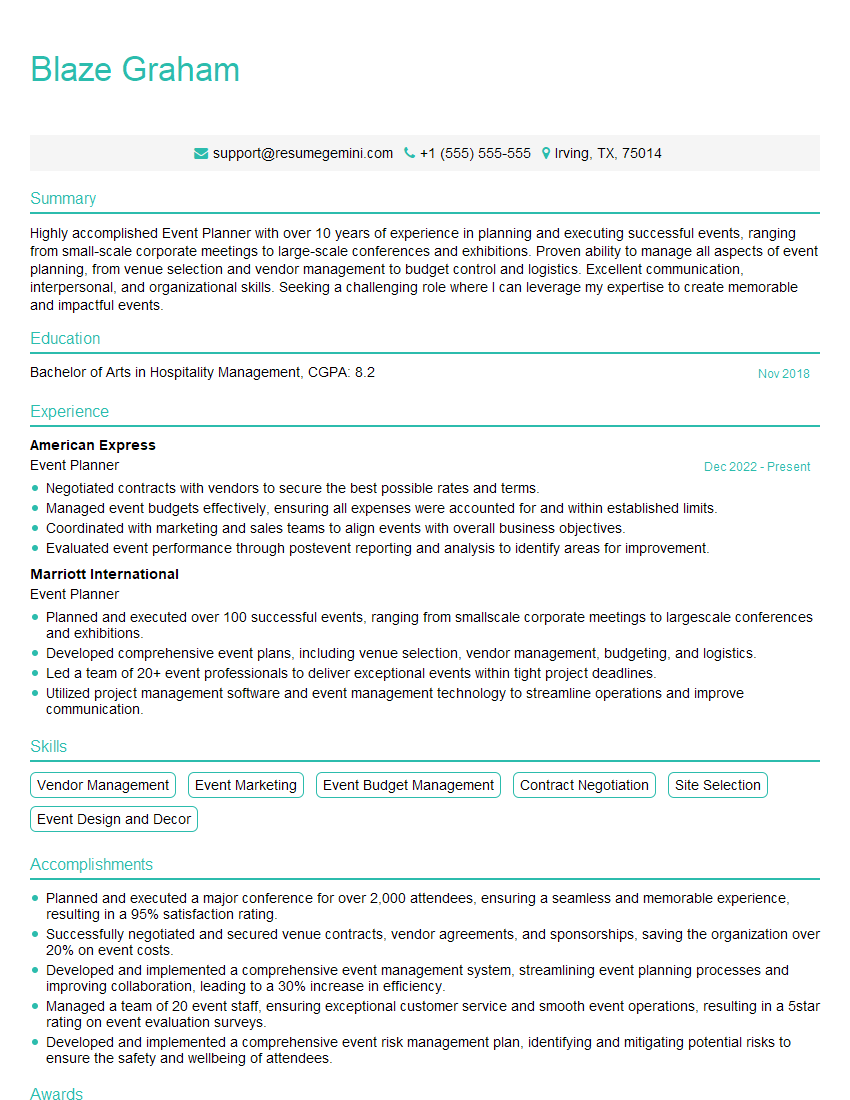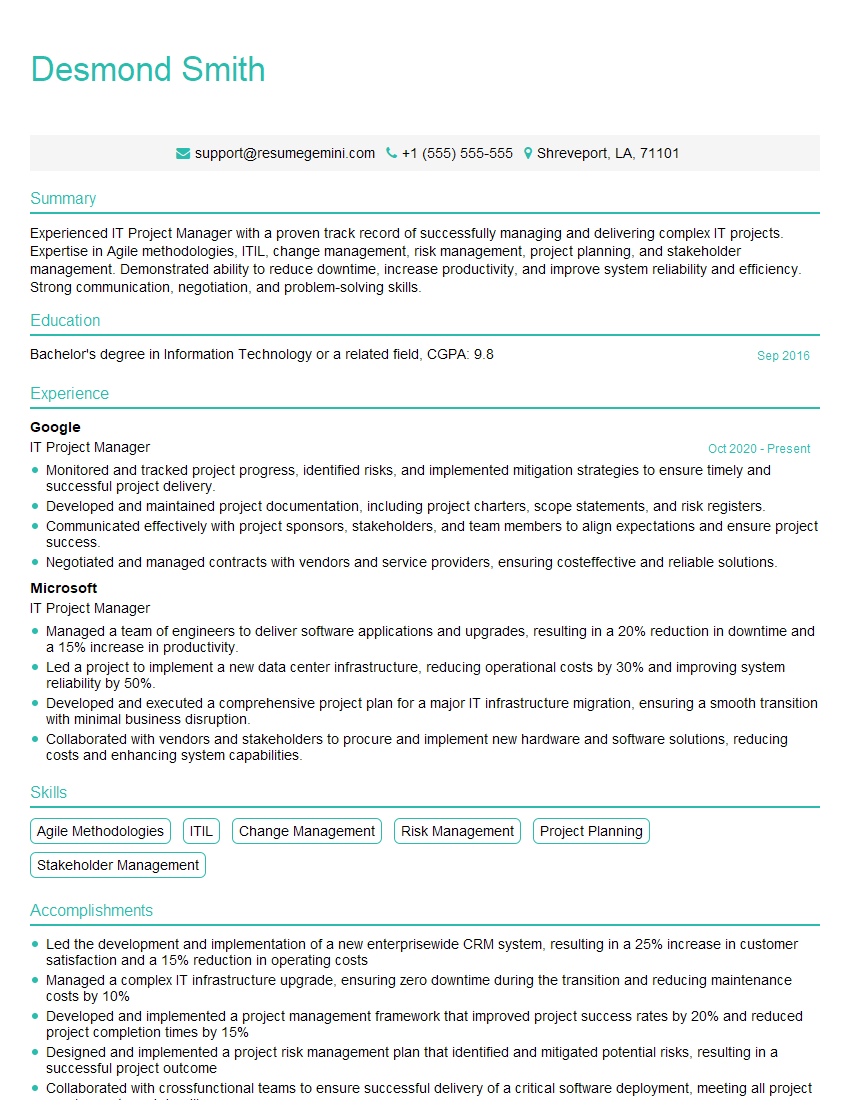Are you ready to stand out in your next interview? Understanding and preparing for Pace Judgment and Timing interview questions is a game-changer. In this blog, we’ve compiled key questions and expert advice to help you showcase your skills with confidence and precision. Let’s get started on your journey to acing the interview.
Questions Asked in Pace Judgment and Timing Interview
Q 1. Describe a situation where you had to adjust your pace due to unexpected circumstances.
Adjusting pace due to unexpected circumstances is a crucial skill in project management and life in general. It involves recognizing when a deviation from the planned timeline is necessary and adapting accordingly. This often requires flexibility, quick thinking, and the ability to re-prioritize tasks.
For example, I was once leading a team developing a software application with a tight deadline. Two days before launch, a critical bug was discovered in a core module. Instead of panicking, I immediately convened a team meeting. We assessed the severity of the bug, the time needed for a fix, and the potential impact on the launch date. We decided to prioritize the bug fix above all else, postponing some less critical features to a post-launch update. This required re-allocating team members and extending the work hours, but ultimately prevented a catastrophic launch failure. The lesson? Flexibility and proactive communication are key when facing the unexpected.
Q 2. How do you prioritize tasks when faced with multiple deadlines?
Prioritizing tasks with multiple deadlines requires a structured approach. I typically use a combination of techniques, including the Eisenhower Matrix (urgent/important), MoSCoW method (Must have, Should have, Could have, Won’t have), and a simple prioritization matrix based on impact and effort. The Eisenhower Matrix helps categorize tasks based on urgency and importance, allowing me to focus on urgent and important tasks first. MoSCoW allows for effective scope management and realistic expectation setting. The effort/impact matrix gives a clearer picture of which tasks deliver the most value within the least amount of time.
For instance, if I had deadlines for a report, a presentation, and a meeting, I would assess the impact of missing each deadline and the effort required to complete each task. The report with a critical deadline and high impact might take priority over a less important presentation.
Q 3. Explain your approach to time management in a high-pressure environment.
Time management in high-pressure environments hinges on proactive planning, effective delegation, and the ability to maintain focus. I employ techniques like time blocking (allocating specific time slots for tasks), the Pomodoro Technique (working in focused bursts with short breaks), and regular progress reviews. Clear communication with stakeholders is paramount to ensure everyone is aligned and understands potential challenges. Prioritization becomes even more critical in this scenario; focusing on high-impact tasks first helps maximize output under pressure.
During a particularly demanding project involving several simultaneous deadlines, I used a combination of time blocking and the Pomodoro Technique. I dedicated specific blocks of time to high-priority tasks, utilizing the Pomodoro Technique to maintain focus during those blocks. This structured approach helped prevent feeling overwhelmed and improved overall productivity despite the pressure.
Q 4. How do you identify potential delays in a project and mitigate their impact?
Identifying and mitigating potential project delays requires a proactive and systematic approach. This includes creating detailed project plans with realistic timelines, conducting regular risk assessments, and establishing clear communication channels. Risk assessments help identify potential issues before they impact the project, and this information should be shared openly and honestly with stakeholders. Having a well-defined contingency plan is also crucial; this outlines steps to take should delays occur.
In a recent project, our risk assessment highlighted potential supplier delays. To mitigate this, we built in buffer time into the schedule and sourced alternative suppliers. This proactive approach ensured that the project stayed on track despite the eventual delay from the primary supplier.
Q 5. How do you balance speed and accuracy in your work?
Balancing speed and accuracy involves understanding that both are critical for success. It’s not a trade-off, but rather a delicate balance. Rushing without careful consideration can lead to costly errors, while excessive meticulousness can cause delays. I find that using checklists, double-checking work, and utilizing tools for automation helps strike this balance. Focusing on the critical aspects of a task first and progressively refining the details also proves effective.
For example, when writing a report, I might first focus on getting the main points down quickly, ensuring the overall flow is correct. Then, I would go back and check for accuracy, grammar, and formatting.
Q 6. Describe a time you underestimated the time needed for a task. What did you learn?
Underestimating the time needed for a task is a common pitfall, often resulting from a lack of experience or insufficient planning. Once, I underestimated the complexity of integrating a new software module into an existing system. I initially planned for two days, but it ended up taking five. The learning experience was invaluable. I realized the importance of breaking down complex tasks into smaller, more manageable units. Thorough planning and realistic estimations are essential, factoring in potential unforeseen complications. Learning to accurately assess task complexity and allowing for buffer time became crucial improvements in my workflow.
Q 7. How do you delegate tasks effectively to meet deadlines?
Effective delegation involves selecting the right person for the task, providing clear instructions and expectations, offering necessary support and resources, and setting realistic deadlines. I ensure that the individual understands the task’s goals, the expected outcome, and the available resources. Regular check-ins and open communication channels are maintained to monitor progress and address potential challenges. The key to successful delegation is trust and empowerment of team members.
In a previous project, I had to delegate data analysis to a junior member of the team. I provided them with detailed instructions, access to the relevant data, and scheduled regular check-in meetings to discuss progress and answer any questions. This approach allowed the team member to develop their skills while contributing effectively to the project, meeting deadlines and high quality standards.
Q 8. How do you monitor your progress against deadlines?
Monitoring progress against deadlines is crucial for successful project management. I employ a multi-faceted approach combining proactive planning with regular, rigorous tracking. This begins with a detailed work breakdown structure (WBS) that clearly defines tasks, dependencies, and estimated durations. I then utilize project management software (more on that later) to input these details, creating a visual timeline and assigning deadlines.
My monitoring strategy involves daily check-ins to assess progress against the schedule. I use a combination of self-reporting, team meetings, and progress reports to identify any deviations. Any delays are immediately flagged, investigated for root causes (e.g., resource constraints, unexpected issues), and solutions are implemented promptly. I also regularly review the critical path – the sequence of tasks that determine the shortest possible project duration – to ensure it remains on track. Regular updates to the project schedule, with justification for any changes, maintain transparency and keep everyone informed.
For example, during a recent website redesign project, a delay in securing necessary client approvals pushed back the content migration phase. By identifying this early through daily monitoring, we proactively adjusted the timeline for subsequent tasks and ensured the overall project deadline wasn’t compromised.
Q 9. What strategies do you use to prevent burnout when working under pressure?
Preventing burnout under pressure is paramount to both individual well-being and project success. My strategies are centered around proactive self-care and effective time management. This includes prioritizing tasks based on urgency and importance using methods like the Eisenhower Matrix (urgent/important). I break down large tasks into smaller, more manageable chunks to avoid feeling overwhelmed.
I also incorporate regular breaks into my workday, aiming for short, focused work sessions with designated rest periods in between. This technique, known as the Pomodoro Technique, helps maintain concentration and prevents mental fatigue. Beyond work, I prioritize activities that help me recharge, such as exercise, spending time in nature, or pursuing hobbies. Open communication with my team and manager is key; I don’t hesitate to ask for help when needed or to discuss workload adjustments if I’m feeling stretched too thin. Building a supportive work environment is crucial for long-term sustainability.
For instance, during a particularly demanding product launch, I consciously scheduled regular walks during my lunch break and ensured I adhered to my planned evenings off. This prevented me from feeling depleted and allowed me to approach challenges with renewed energy and focus.
Q 10. How do you handle conflicting priorities?
Handling conflicting priorities requires a structured and decisive approach. My first step is to clearly identify all competing priorities and assess their relative importance and urgency. I often use a prioritization matrix (like the Eisenhower Matrix) to visualize this. Then, I analyze the dependencies between tasks – which tasks must be completed before others can begin? – to understand the constraints.
Next, I communicate openly with stakeholders to establish shared understanding and potentially negotiate adjustments. Sometimes, re-prioritization involves making difficult choices; I might need to postpone or delegate less critical tasks to focus on those that are most urgent and impactful. Transparent communication throughout this process is crucial to avoid misunderstandings and maintain positive working relationships. Regular re-evaluation of priorities is also necessary, especially during dynamic projects where circumstances can change quickly.
In one project, we had competing demands for developing a new feature and fixing critical bugs. After careful analysis and discussion with the development team and product owner, we prioritized bug fixes due to their higher impact on user experience and stability. The new feature was then scheduled for the next development sprint.
Q 11. Describe your experience with project scheduling software.
I have extensive experience with various project scheduling software, including Jira, Asana, and Microsoft Project. My proficiency extends beyond simply inputting data; I leverage their features to enhance team collaboration, track progress effectively, and manage risks proactively. I’m comfortable creating Gantt charts, defining dependencies between tasks, and utilizing features like resource allocation and time tracking.
For instance, in Jira, I utilize Kanban boards to visually represent workflow stages, facilitating transparent progress monitoring for the entire team. In Asana, I create custom fields to track key metrics specific to a project, enabling a more granular understanding of progress. Microsoft Project’s critical path analysis helps me identify bottlenecks and potential delays early in the project lifecycle.
Beyond the technical aspects, I understand the importance of choosing the right tool for the project’s needs and the team’s capabilities. The best software isn’t necessarily the most feature-rich; it’s the one that streamlines the workflow and enhances productivity without adding unnecessary complexity.
Q 12. How do you adapt your pace to different team members’ work styles?
Adapting my pace to different team members’ work styles is crucial for effective collaboration. I believe in fostering a culture of open communication and mutual respect. I start by understanding individual strengths, preferences, and working styles through informal conversations and observation. This helps me anticipate potential bottlenecks and adjust my approach accordingly.
For those who prefer detailed, structured plans, I provide comprehensive task breakdowns and clear expectations upfront. For those who thrive in a more flexible environment, I offer more autonomy and encourage collaborative problem-solving. Regular check-ins and feedback sessions allow me to gauge progress, address any concerns, and adapt my communication and support style as needed. I avoid imposing my own pace; instead, I focus on facilitating a workflow that supports the collective goals while accommodating individual needs.
For example, on a recent project, I worked with a team member who preferred a more independent approach. Instead of micromanaging, I focused on setting clear objectives and providing regular support through brief check-ins, allowing them the space to work at their own optimal pace while keeping the project on track.
Q 13. How do you determine the appropriate pace for a given project?
Determining the appropriate pace for a project is a nuanced process that considers multiple factors. It starts with a realistic assessment of the project scope, complexities, and available resources. This involves a detailed breakdown of tasks, estimation of their durations, identification of dependencies, and assessment of potential risks. Historical data from similar projects can provide valuable insights into realistic timelines.
Next, I consider the team’s capacity and expertise. A project requiring specialized skills might necessitate a slower pace to allow for adequate learning or collaboration. Similarly, a smaller team with limited resources will likely require a more cautious pace than a larger, well-resourced team. Finally, I factor in external constraints like deadlines, stakeholder expectations, and potential unforeseen circumstances. A buffer is often built into the schedule to account for unexpected delays or challenges.
The ideal pace is a balance between speed and quality. Rushing can compromise quality, while being overly cautious can lead to missed opportunities. Continuous monitoring and adjustments are essential to ensure the project remains on schedule without compromising quality or team well-being.
Q 14. How do you assess the risk of delays?
Assessing the risk of delays involves a proactive and systematic approach. I begin by identifying potential risk factors, which can be categorized into various areas: technical challenges, resource constraints, external dependencies, and unforeseen events. For each identified risk, I analyze its likelihood of occurrence and the potential impact on the project timeline and budget.
I use risk assessment matrices to visually represent these risks, allowing for prioritization and planning of mitigation strategies. This might involve allocating contingency time in the schedule, securing additional resources, developing backup plans, or implementing contingency measures. Regular monitoring and review of risks are essential, particularly in dynamic environments where circumstances can change quickly. Open communication about potential risks and planned mitigation strategies is key to keeping the team informed and prepared.
For example, in a software development project, the risk of unforeseen bugs was identified as a significant factor. To mitigate this, we implemented rigorous testing procedures, allocated additional time for debugging, and established clear escalation paths for critical issues. This proactive approach minimized the impact of unexpected delays.
Q 15. How do you communicate progress updates effectively?
Effective progress updates are concise, factual, and tailored to the audience. They shouldn’t just report what’s been done, but also highlight any challenges encountered and the plan to overcome them. I aim for a balance between providing enough detail for informed decision-making without overwhelming the recipient with unnecessary information.
For instance, instead of saying “Worked on Project X,” I’d say: “Completed the initial design phase for Project X, as scheduled. However, we encountered an unexpected incompatibility with the legacy system, which I’m addressing by [briefly explain solution]. I anticipate a minor delay of one day, but I’ll keep you updated if this changes.”
I regularly use project management tools to track progress visually. These tools can create automatically generated reports that show task completion and timelines, which I can then use to quickly generate updates for stakeholders.
Career Expert Tips:
- Ace those interviews! Prepare effectively by reviewing the Top 50 Most Common Interview Questions on ResumeGemini.
- Navigate your job search with confidence! Explore a wide range of Career Tips on ResumeGemini. Learn about common challenges and recommendations to overcome them.
- Craft the perfect resume! Master the Art of Resume Writing with ResumeGemini’s guide. Showcase your unique qualifications and achievements effectively.
- Don’t miss out on holiday savings! Build your dream resume with ResumeGemini’s ATS optimized templates.
Q 16. What metrics do you use to track your time management effectiveness?
I track my time management effectiveness using a combination of metrics. Key metrics include:
- Task Completion Rate: This is a simple measure of how many tasks I complete within the allotted time. I track this using daily/weekly to-do lists, marking off completed items.
- Project Completion Rate: This focuses on larger projects, tracking milestones reached versus projected timelines. Project management software is invaluable for this.
- Time Spent vs. Time Budgeted: Analyzing how much time I actually spend on tasks compared to my initial estimates helps identify areas for improvement in time estimation and prioritization. Time tracking software significantly aids this.
- Cycle Time: For repetitive tasks, I monitor the time taken from start to finish, looking for ways to streamline processes and reduce cycle time.
Regularly reviewing these metrics allows me to identify trends and adapt my time management strategies accordingly.
Q 17. How do you handle interruptions and maintain focus?
Interruptions are inevitable, but their impact can be minimized. My approach is two-pronged: prevention and mitigation.
- Prevention: I schedule dedicated focus blocks in my calendar, communicating my availability to colleagues during these times. I also utilize the “do not disturb” features on my communication tools during these periods.
- Mitigation: When interrupted, I quickly note down what I was working on to easily resume. If the interruption is brief, I address it immediately and return to my task. For longer interruptions, I schedule a brief time to address them later. This prevents task-switching and maintains focus.
Think of it like a potter at their wheel – interruptions are like someone bumping the table. Prevention is like having a stable table. Mitigation is about quickly readjusting after a bump, ensuring you don’t lose your focus entirely.
Q 18. Describe a time you successfully managed multiple projects simultaneously.
During my previous role, I successfully managed three concurrent projects: website redesign, a new marketing campaign, and a software update. Each project had its own timeline, stakeholders, and deliverables.
My approach involved:
- Prioritization: I identified the most critical tasks for each project based on deadlines and impact, creating a prioritized task list.
- Time Blocking: I allocated specific time blocks in my day for each project, ensuring dedicated focus time.
- Regular Communication: I maintained consistent communication with stakeholders across all projects, proactively sharing updates and addressing concerns.
- Delegation: Where possible, I delegated tasks to team members, ensuring clear instructions and deadlines.
This structured approach allowed me to meet the deadlines of all three projects while maintaining quality. The key was to be organized, communicative, and flexible – adjusting my schedule as needed.
Q 19. How do you anticipate potential roadblocks and plan accordingly?
Anticipating roadblocks is crucial for effective time management. I utilize a proactive approach:
- Risk Assessment: Before starting a project, I identify potential challenges, such as resource constraints, technical difficulties, or dependency issues.
- Contingency Planning: I develop alternative plans or solutions for each potential roadblock. This might involve identifying backup resources, exploring workaround solutions, or adjusting timelines.
- Regular Monitoring: Throughout the project, I continuously monitor progress, watching for any early warning signs of potential delays or problems. This allows for timely intervention.
For example, if I anticipate a delay in receiving crucial data from a third party, I’ll build that potential delay into my project timeline. I might also explore alternative data sources as a backup.
Q 20. What are some common time management pitfalls you avoid?
Several common time management pitfalls I actively avoid include:
- Perfectionism: Striving for perfection can lead to analysis paralysis and missed deadlines. I focus on achieving the minimum viable product (MVP) first, then iterating based on feedback.
- Poor Prioritization: Tackling urgent tasks before important ones can lead to long-term inefficiencies. I use prioritization matrices (like Eisenhower Matrix) to focus on high-impact tasks.
- Multitasking: While it feels productive, multitasking reduces efficiency. I focus on one task at a time for better concentration and results.
- Overcommitment: Taking on too much work leads to burnout and decreased quality. I’m mindful of my capacity and politely decline additional work when necessary.
- Lack of Planning: Starting tasks without a plan leads to wasted time and effort. I invest time in planning and breaking down larger projects into smaller, manageable tasks.
Q 21. How do you leverage technology to enhance your time management?
Technology plays a significant role in enhancing my time management. I leverage various tools:
- Project Management Software (e.g., Asana, Trello, Jira): These tools facilitate task organization, collaboration, and progress tracking.
- Calendar Applications (e.g., Google Calendar, Outlook Calendar): Scheduling tasks and appointments helps visualize workload and manage time effectively. I use color-coding to differentiate project types.
- Time Tracking Software (e.g., Toggl Track, Clockify): Tracking time spent on different tasks helps me understand time allocation and identify areas needing improvement. This data feeds into my performance metrics.
- Note-Taking Apps (e.g., Evernote, OneNote): Capturing ideas, meeting notes, and project details keeps everything organized and accessible.
- Automation Tools (e.g., Zapier, IFTTT): Automating repetitive tasks, such as scheduling social media posts or sending email reminders, frees up valuable time.
Choosing the right tools and integrating them into a cohesive workflow is key to maximizing their effectiveness.
Q 22. How do you stay organized and track your tasks efficiently?
Staying organized and tracking tasks efficiently is paramount for effective time management. My approach is multifaceted, combining digital tools with structured methodologies. I primarily use a project management system like Asana or Trello, leveraging their Kanban board functionality to visualize workflow. Tasks are broken down into smaller, manageable sub-tasks, each with clear deadlines and assigned priorities. I utilize color-coding for different project stages (e.g., to-do, in progress, completed) for a quick overview. Beyond digital tools, I maintain a daily to-do list, prioritizing tasks using methods like the Eisenhower Matrix (urgent/important), ensuring focus on high-impact activities. Regular review and adjustment of these lists are crucial; I typically dedicate a few minutes each morning and evening to re-evaluate priorities and track progress.
- Example: For a large project, I might break it down into phases (research, design, development, testing). Each phase is a column on my Kanban board, and each task within those phases is a card.
- Example: I might use a time-blocking technique, scheduling specific blocks of time for focused work on particular tasks.
Q 23. How do you proactively identify and address potential time constraints?
Proactive identification of time constraints is key to successful project delivery. I begin by realistically assessing the scope of a project, breaking it down into its constituent parts and estimating the time required for each. This often involves consulting historical data on similar projects, or engaging in discussions with team members to gain diverse perspectives. I then build in buffer time – a crucial element often overlooked – to account for unexpected delays or unforeseen complexities. This buffer isn’t just about adding extra time; it’s strategically placed within the schedule to allow for flexibility. I also utilize critical path analysis, identifying tasks that directly impact the overall project timeline, allowing for focused attention and resource allocation to those critical areas. Regularly monitoring progress against the schedule and flagging potential issues early, allows for mitigation strategies before they become major setbacks.
- Example: If a task is consistently taking longer than expected, I’ll investigate the cause and potentially adjust the schedule, allocate additional resources, or simplify the task.
Q 24. How do you measure your productivity?
Measuring productivity is not solely about the number of hours worked but the value delivered. My approach involves a combination of quantitative and qualitative measures. Quantitatively, I track completed tasks, milestones achieved, and deliverables produced against the planned schedule. This data allows for objective assessment of progress. Qualitatively, I consider the quality of work produced, client satisfaction, and team feedback. A productive day isn’t just about ticking off boxes; it’s about delivering high-quality output that meets or exceeds expectations. I also regularly reflect on my own work processes, seeking areas for improvement in efficiency and effectiveness.
- Example: For a software development project, I might track the number of lines of code written, features implemented, and bugs resolved.
- Example: For a marketing campaign, I might track website traffic, lead generation, and conversion rates.
Q 25. How do you handle setbacks or unexpected changes in project timelines?
Setbacks and unexpected changes are inevitable in project management. My response is based on a calm and systematic approach. First, I acknowledge the problem and assess its impact on the overall project timeline and deliverables. Then, I gather relevant information to understand the root cause of the setback. Next, I explore potential solutions, considering their implications on the project scope, budget, and resources. This often involves communication with stakeholders to explain the situation and collaboratively identify the best course of action. This might involve adjusting priorities, reallocating resources, or renegotiating deadlines. Documentation of these changes and their justifications is crucial for transparency and accountability. Finally, I incorporate lessons learned from this experience into future projects, improving our preparedness for similar situations.
- Example: If a key team member is unavailable, I might reassign tasks, or adjust the project schedule to account for the absence.
Q 26. Describe your experience using Gantt charts or similar project management tools.
Gantt charts and similar project management tools are integral to my workflow. I frequently use Gantt charts to visually represent project timelines, dependencies between tasks, and resource allocation. These charts provide a clear overview of the project’s critical path, helping to identify potential bottlenecks and risks. The ability to track progress against the schedule, easily identify delays, and communicate project status to stakeholders makes them invaluable. I’m proficient in using software like Microsoft Project or Smartsheet, leveraging their features for task dependencies, resource management, and progress tracking. These tools help me manage complex projects with multiple tasks and dependencies, enhancing collaboration and communication among team members.
- Example: In a Gantt chart, I’d visually represent each task as a bar, its length corresponding to its duration, and its position reflecting its start and end dates. Dependencies would be shown as arrows connecting related tasks.
Q 27. What is your process for setting realistic deadlines?
Setting realistic deadlines is a crucial skill based on a combination of experience, data-driven analysis, and stakeholder collaboration. I begin by thoroughly understanding the project scope and complexities. This involves breaking down the project into smaller, manageable tasks and estimating the time required for each based on past experience or industry benchmarks. I then account for potential delays or unforeseen circumstances by adding buffer time. Crucially, I involve stakeholders in the process, ensuring that deadlines are not only realistic but also align with their expectations and priorities. Open communication and collaboration ensure buy-in and shared understanding of the timeline.
- Example: For a web development project, I might estimate the time needed for design, development, testing, and deployment based on similar projects I’ve completed in the past.
Q 28. How do you ensure you are meeting the expectations of your stakeholders regarding project timelines?
Meeting stakeholder expectations regarding project timelines requires proactive communication and transparent reporting. Throughout the project lifecycle, I regularly update stakeholders on progress, highlighting achievements and addressing any potential delays or challenges. I utilize a variety of communication methods, including regular meetings, email updates, and project management software dashboards to ensure consistent and accessible information. I emphasize proactive communication, alerting stakeholders to potential issues early on, allowing for collaborative problem-solving and adjustments to the plan. This approach fosters trust and confidence in the project’s management and delivery.
- Example: I might use a weekly status report to update stakeholders on progress, highlighting any roadblocks and outlining mitigation strategies.
Key Topics to Learn for Pace Judgment and Timing Interview
- Understanding Task Prioritization: Learn to effectively assess tasks based on urgency and importance, allocating time efficiently.
- Time Management Strategies: Explore practical techniques like time blocking, the Pomodoro Technique, and Eisenhower Matrix to optimize workflow and meet deadlines.
- Adaptability and Flexibility: Discuss how to adjust your approach and pace when faced with unexpected challenges or shifting priorities.
- Effective Delegation: Understand when and how to delegate tasks to maximize efficiency and leverage team resources.
- Stress Management under Pressure: Develop strategies for maintaining composure and focus when working under tight deadlines or high-pressure situations.
- Anticipating Potential Delays: Practice identifying potential roadblocks and proactively developing contingency plans.
- Communication and Collaboration: Highlight the importance of clear communication in managing expectations and coordinating with colleagues regarding timelines and deliverables.
- Self-Assessment and Continuous Improvement: Discuss methods for regularly evaluating your time management skills and identifying areas for improvement.
Next Steps
Mastering Pace Judgment and Timing is crucial for career advancement. It demonstrates essential skills employers value highly, leading to increased productivity, improved project management, and greater overall success. To significantly boost your job prospects, create an ATS-friendly resume that highlights these crucial skills. ResumeGemini is a trusted resource to help you build a professional and impactful resume. We provide examples of resumes tailored to Pace Judgment and Timing to guide you. Invest in your career; build a resume that showcases your capabilities effectively.
Explore more articles
Users Rating of Our Blogs
Share Your Experience
We value your feedback! Please rate our content and share your thoughts (optional).
What Readers Say About Our Blog
Hi, I represent an SEO company that specialises in getting you AI citations and higher rankings on Google. I’d like to offer you a 100% free SEO audit for your website. Would you be interested?
good

